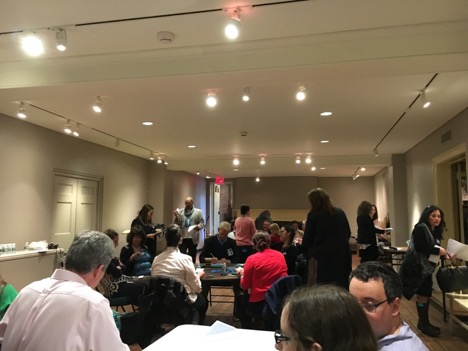Incubating Creativity: Workshopping Historic House Interpretation at Boscobel
Nolan Cool, Public History M.A. Candidate, UMass Amherst
What happens when museum professionals and public historians gather to discuss the future of historic house museums and face the challenge of thinking outside the box? To tackle these hard questions head on, the Greater Hudson Heritage Network (GHHN), New York State Council for the Arts (NYSCA), and “Museum Maverick” and co-author of the Anarchist’s Guide to Historic House Museums (2016) Franklin Vagnone, hosted a “creativity incubator” workshop for regional organizations at Boscobel House and Gardens in Garrison, New York on April 25, 2017. Nearly 40 museum professionals attended the event to explore fresh interpretive ideas and push the boundaries of programming and operations at historic sites and house museums.

Our eager group started the day with introductions and an exercise making sense of context, interpretation, and examining biases in presenting museum collections. To illustrate his point, Vagnone poured the contents of a bowl (represented a museum collection) out on the floor and asked the group to make sense of it. Naturally, we organized the material by type. Playing the role of a selective funder, Vagnone kicked everything out of order, asserting that he only wanted materials that were white in color. Several minutes later, our group placed the white bowl at the center of the floor, filled it with toilet paper, surrounded it with face down index cards, and sorted out white tic tacs, smarties, and life savers. After we completed this hands-on exercise, Vagnone explained that museums often treat collections selectively, thereby actively omitting narratives, stories, and broader context(s) that contribute to a more interesting interpretive narrative. In this collaborative exercise, he labeled standard curation pratices and institutional bias as one in the same. He also explained that selective periodization narrows interpretive opportunities and creates a bland narrative that loses the human aspects of a historic house museum’s story.

Prior to some lunchtime networking, Vagnone delivered an engaging presentation on other museums’ approaches to uniquely adapting collections and historic houses to better engage broader and more diverse communities. In his presentation, he explained that melding “history, collections, and current events” provides organizations with new community partnerships and ways to engage both local and broader audiences. Vagnone cited several examples from the use of fiber arts object reproductions at Philadelphia’s Physick House to creative poetry workshops and readings at New York City’s Lewis Latimer House. Additionally, he handed each one of us a page of the New York Times or a local newspaper, asking us to relate that day’s news to an interpretive thread at our respective sites. This exercise challenged us to not only connect past and present, but illustrated that unshackling organizational neutrality in discussions on contemporary subjects offers museums a more relevant and open way dialogue with current and new audiences.

After lunch, the group headed over to Boscobel, a recreated 1808 home and historic house museum in New York’s Hudson Valley. We were broken into five groups and given a list of objects sorted by room. Vagnone and the organizers challenged us to develop a unique thematic program, project, or experience using these objects as a base. Each group came up with several unique designs, including interpreting a parlor space as a more modern “man cave,” using a theme of “Leisure and the Decadent Arts.” The group I belonged to came up with a museum mascot based on a taxidermy parrot named Fred (after the site’s first director), which featured in all our programs and publications geared toward children, a relatively underserved audience at the museum.


Ultimately, Frank Vagnone’s challenges proved highly engaging, thought-provoking, and widely applicable to challenging a stagnating status quo regarding interpretive approaches at historic house museums. Reframing interpretation to reflect a less rigid and more accessible, experimental experience between visitors, communities, and institutions challenges cultural organizations to cultivate new experiences for the modern world in historic spaces. Historic houses need to better reflect the diversity of perspectives, interests, stories, and history existing in the communities around them, and it starts with providing exciting experiences to an institution’s neighbors.
